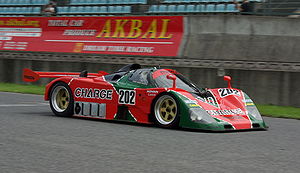
Mazda 767
Encyclopedia

Mazda
is a Japanese automotive manufacturer based in Fuchū, Aki District, Hiroshima Prefecture, Japan.In 2007, Mazda produced almost 1.3 million vehicles for global sales...
767/767B were prototype racing cars built by Mazdaspeed
Mazdaspeed
Mazdaspeed is Mazda's in-house race and street car tuning arm. It began in 1968 as "Mazda Sports Corner", a tuning and racing operation run by Takayoshi Ohashi, who also ran Mazda's Tokyo distributor...
for the 24 Hours of Le Mans
24 Hours of Le Mans
The 24 Hours of Le Mans is the world's oldest sports car race in endurance racing, held annually since near the town of Le Mans, France. Commonly known as the Grand Prix of Endurance and Efficiency, race teams have to balance speed against the cars' ability to run for 24 hours without sustaining...
running under the IMSA
International Motor Sports Association
The International Motor Sports Association is an American sports car auto racing sanctioning body based in Braselton, Georgia. It was started by John Bishop, a former employee of SCCA , and his wife Peggy in 1969 with help from Bill France, Sr...
-spec GTP
IMSA GT Championship
IMSA GT was a sports car racing series organized by International Motor Sports Association. Races took place primarily in the United States and occasionally in Canada.-History:...
class. The 767 replaced the 757
Mazda 757
The Mazda 757 was a prototype racing car built by Mazdaspeed for the 24 Hours of Le Mans running under the IMSA-spec GTP class. It replaced the previous lineage of Group C2 class cars which ended with the 737C and was the first chassis built entirely by Mazdaspeed and designed by Nigel Stroud...
in 1988, upgrading to a newer and larger 4-rotor 13J Wankel engine
Wankel engine
The Wankel engine is a type of internal combustion engine using an eccentric rotary design to convert pressure into a rotating motion instead of using reciprocating pistons. Its four-stroke cycle takes place in a space between the inside of an oval-like epitrochoid-shaped housing and a rotor that...
which produced nearly 600 hp.
Two 767s were entered at 1988 24 Hours of Le Mans
1988 24 Hours of Le Mans
The 1988 24 Hours of Le Mans was the 56th Grand Prix of Endurance, and took place on June 11 and 12 1988. It was also the fifth round of the World Sports-Prototype Championship season.-Race:...
, finishing 17th and 19th overall, however they finished behind a sole 757
Mazda 757
The Mazda 757 was a prototype racing car built by Mazdaspeed for the 24 Hours of Le Mans running under the IMSA-spec GTP class. It replaced the previous lineage of Group C2 class cars which ended with the 737C and was the first chassis built entirely by Mazdaspeed and designed by Nigel Stroud...
which was able to finish 15th. In the All Japan Sports Prototype Championship
All Japan Sports Prototype Championship
The , abbreviated as JSPC, formed by the Japanese Automobile Federation, was a domestic championship which took place in Japan for Group C and IMSA GTP prototype cars and also featured cars that were eligible for touring car racing in its earlier years...
, Mazda managed 4th in the constructor's championship. For 1989, Mazda upgraded the 767 into the 767B, and initially tested it in the IMSA
International Motor Sports Association
The International Motor Sports Association is an American sports car auto racing sanctioning body based in Braselton, Georgia. It was started by John Bishop, a former employee of SCCA , and his wife Peggy in 1969 with help from Bill France, Sr...
24 Hours of Daytona
24 Hours of Daytona
The 24 Hours of Daytona, currently known as the Rolex 24 Daytona for sponsorship reasons, is a 24-hour sports car endurance race held annually at Daytona International Speedway in Daytona Beach, Florida. It is run on a combined road course, utilizing portions of the NASCAR tri-oval and an infield...
, where it was successful in finishing 5th overall. Later in the year, Mazda returned to Le Mans with two 767Bs as well as an older 767. The 767Bs were able to finish 7th and 9th overall, while the lone 767 was able to finish 12th. However, in JSPC, the results were not as promising, as Mazda finished a mere 5th in the championship. For 1990
1990 24 Hours of Le Mans
The 1990 24 Hours of Le Mans was the 58th Grand Prix of Endurance, and took place on June 16 and 17 1990.-Pre-race:This was the first race after the installation of two chicanes along the Mulsanne Straight in an attempt to slow the prototypes down after speeds of were reached in previous...
, a single 767B was entered alongside two newer 787
Mazda 787B
The Mazda 787 and its derivative 787B were Group C sports prototype racing cars built by Mazda for use in the World Sportscar Championship, All Japan Sports Prototype Championship, as well as the 24 Hours of Le Mans from 1990 to 1991...
s, and was the only car of the three to finish, although in 20th overall.

